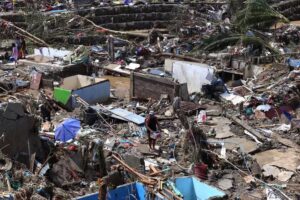The fragile balance of life in Southeast Asia has been brutally exposed by the ravages of Typhoon Kalmaegi (locally known as Tino), which has left a widening trail of devastation across the Philippines and Vietnam. Days after the destructive storm tore through the region, the official death toll in the Philippines has surged to nearly 200, prompting a frantic search-and-rescue operation and a declaration of a national state of calamity. The unfolding humanitarian crisis is compounded by the ominous forecast of a second, potentially more powerful storm—Supertyphoon Fung-Wong—bearing down on the archipelago.
I. The Calamity in the Philippines: A Nation Under Water

The latest figures released by the Philippine News Agency, citing government data, tragically confirm that at least 188 people have been killed by Typhoon Kalmaegi. This represents a stark jump from the 114 fatalities reported just the previous day, underscoring the severity of the situation as floodwaters recede and the full scope of the disaster becomes clear. Furthermore, authorities reported a devastating count of at least 127 people still missing, suggesting the final death toll could climb even higher.
The typhoon, which first struck the Philippines on Tuesday, transformed vulnerable low-lying communities into catastrophic disaster zones. Visual evidence—photos and videos shared globally—depicts a terrifying landscape of submerged automobiles, uprooted trees, and streets choked with thick, destructive mud. The torrential rains and fierce winds forced a massive civilian operation, with more than 560,000 residents displaced. The Associated Press, citing the country’s Office of Civil Defense, noted that nearly 450,000 people were moved to emergency shelters, with over 200,000 evacuated preemptively ahead of landfall.
Cebu: The Epicenter of Loss
The province of Cebu, a renowned global tourist destination celebrated for its pristine beaches and vibrant culture, appears to be among the hardest hit areas. The storm’s impact here has been catastrophic, turning scenic coastal areas into scenes of despair and destruction.
Striking drone footage from Talisay city, a community within Cebu, showcased riverbanks where houses were brutally flattened and covered in a thick layer of mud, leaving residents to salvage what little remained of their homes and livelihoods. Army and civilian rescue teams are engaged in a desperate race against time, sifting through the debris of low-lying communities particularly susceptible to the storm’s flash flooding. The horrifying scenes of submerged cars floating down once-busy streets in Cebu City on November 4th illustrate the sheer, overwhelming power of Kalmaegi’s flood surge.
In response to the widespread destruction spanning over ten of the country’s regions, Philippine President Ferdinand Marcos Jr. officially declared a “state of national calamity”. This crucial measure, as the President explained to reporters, is necessary to “give us quicker access to some of the emergency funds” and significantly expedite the procurement and distribution of essential aid and relief supplies to the millions affected.
II. Kalmaegi’s Second Act: Landfall in Vietnam
After traversing the South China Sea, Typhoon Kalmaegi delivered its second wave of impact on Thursday, making landfall in Vietnam’s central region. Vietnamese government officials and disaster prevention units confirmed the storm’s arrival, reporting initial wind speeds of up to 82 mph (132 km/h).
While the storm was projected to gradually weaken as it continued its northwesterly track, the immediate danger of flooding remained critical, particularly in the country’s southern urban centers. The U.S. Embassy in Vietnam issued a grave weather alert, highlighting a heightened risk of flooding along the Saigon River. This risk was particularly acute for Ho Chi Minh City, the country’s financial hub, where the coincidence of heavy typhoon-related rains and an anticipated high tide created a perfect storm for severe urban inundation, local authorities warned.
The terrifying visuals preceding the landfall showed the sea being whipped violently at Quy Nhon beach in Gia Lai province, a stark demonstration of the immense energy the typhoon carried. Following its destructive track through Vietnam, the fast-moving system was forecast to further menace inland Southeast Asia, with Cambodia and Thailand next in its projected path.
III. The Looming Threat: Supertyphoon Fung-Wong
Even as rescue efforts continue in the mud-caked ruins left by Kalmaegi, the region faces the psychological and physical burden of an impending catastrophe. To the east of the Philippines, another weather system, Typhoon Fung-Wong, is rapidly gaining strength and intensity.
Current meteorological forecasts are alarming: Fung-Wong is projected to escalate into a Category 4-equivalent supertyphoon over the weekend. The storm’s likely track is set to bring catastrophic consequences—including flooding rain, life-threatening storm surge, and damaging winds—to northern Luzon from Sunday into Monday. While the storm’s most severe impacts are currently expected to remain north of the nation’s densely populated capital, Manila, the proximity of a second, ultra-powerful cyclone just days after the devastation of Kalmaegi poses an unprecedented challenge for disaster management and relief resources.
IV. A Region on the Front Lines of Climate Change
The one-two punch delivered by Kalmaegi and the threat of Fung-Wong underscores the extreme vulnerability of Southeast Asian nations, which are on the front lines of the global climate crisis.
Climate scientists consistently warn that while the overall number of tropical cyclones may not increase dramatically, the intensity and destructiveness of individual storms are rising due to warming ocean temperatures. Warmer waters act as “fuel,” increasing the rate of evaporation and allowing storms like Kalmaegi and Fung-Wong to rapidly intensify and carry significantly more moisture, leading to heavier rainfall and more catastrophic flooding.
The reality of back-to-back mega-storms is a growing nightmare for regions like the Philippines and Vietnam. When one typhoon strikes, it saturates the soil, fills rivers, and weakens critical infrastructure. The arrival of a second storm on the heels of the first, even if slightly weaker, can act as a tipping point for compounded, catastrophic damage, turning an already grave situation into an overwhelming humanitarian disaster.
V. The Road Ahead: Recovery and Resilience
As both the Philippines and Vietnam navigate the immediate aftermath—with countless residents in evacuation centers, families mourning their dead, and critical infrastructure requiring massive repair—the long-term focus must pivot toward resilience and climate adaptation. President Marcos Jr.’s declaration is an acknowledgement that the scale of this disaster requires national mobilization.
The ordeal of Kalmaegi and the threat of Fung-Wong serve as a potent and urgent call for international climate action and increased aid for disaster preparedness in vulnerable developing nations. For the people of Southeast Asia, the fight for recovery is just beginning, even as the skies darken with the forecast of yet another monstrous storm on the horizon. The coming days will test the limit of the region’s spirit and its ability to withstand the new, harsher reality of a changing climate.





